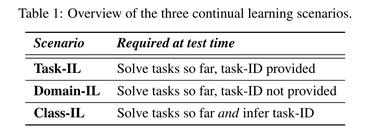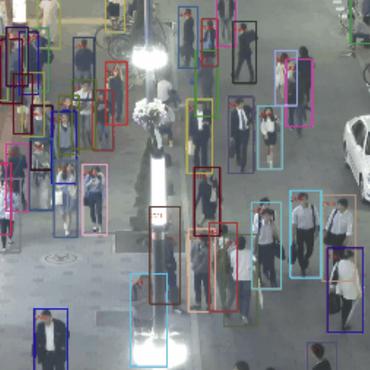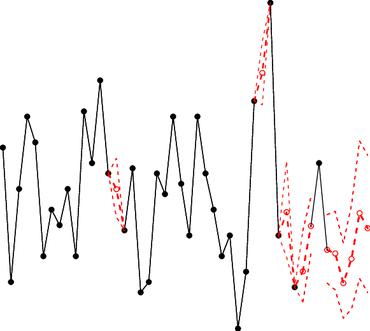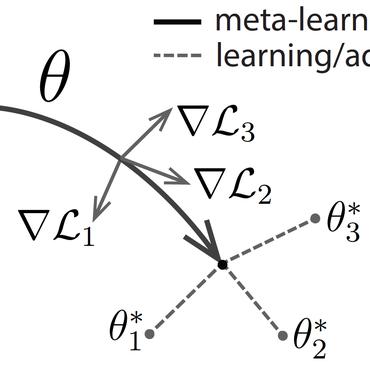Search Results for author: QinGhua Hu
Found 64 papers, 39 papers with code
Visible and Clear: Finding Tiny Objects in Difference Map
no code implementations • 18 May 2024 • Bing Cao, Haiyu Yao, Pengfei Zhu, QinGhua Hu
In addition, we further propose a new multi-instance anti-UAV dataset, which is called DroneSwarms dataset and contains a large number of tiny drones with the smallest average size to date.
Multimodal Fusion on Low-quality Data: A Comprehensive Survey
no code implementations • 27 Apr 2024 • Qingyang Zhang, Yake Wei, Zongbo Han, Huazhu Fu, Xi Peng, Cheng Deng, QinGhua Hu, Cai Xu, Jie Wen, Di Hu, Changqing Zhang
Multimodal fusion focuses on integrating information from multiple modalities with the goal of more accurate prediction, which has achieved remarkable progress in a wide range of scenarios, including autonomous driving and medical diagnosis.
CKD: Contrastive Knowledge Distillation from A Sample-wise Perspective
no code implementations • 22 Apr 2024 • Wencheng Zhu, Xin Zhou, Pengfei Zhu, Yu Wang, QinGhua Hu
Note that constraints on intra-sample similarities and inter-sample dissimilarities can be efficiently and effectively reformulated into a contrastive learning framework with newly designed positive and negative pairs.
Socialized Learning: A Survey of the Paradigm Shift for Edge Intelligence in Networked Systems
no code implementations • 20 Apr 2024 • Xiaofei Wang, Yunfeng Zhao, Chao Qiu, QinGhua Hu, Victor C. M. Leung
In response to these issues, this paper introduces socialized learning (SL) as a promising solution, further propelling the advancement of EI.
AMU-Tuning: Effective Logit Bias for CLIP-based Few-shot Learning
1 code implementation • 13 Apr 2024 • Yuwei Tang, Zhenyi Lin, Qilong Wang, Pengfei Zhu, QinGhua Hu
To this end, we disassemble three key components involved in computation of logit bias (i. e., logit features, logit predictor, and logit fusion) and empirically analyze the effect on performance of few-shot classification.
Task-Customized Mixture of Adapters for General Image Fusion
1 code implementation • 19 Mar 2024 • Pengfei Zhu, Yang Sun, Bing Cao, QinGhua Hu
These adapters are shared across different tasks and constrained by mutual information regularization, ensuring compatibility with different tasks while complementarity for multi-source images.
Invariant Test-Time Adaptation for Vision-Language Model Generalization
1 code implementation • 1 Mar 2024 • Huan Ma, Yan Zhu, Changqing Zhang, Peilin Zhao, Baoyuan Wu, Long-Kai Huang, QinGhua Hu, Bingzhe Wu
Vision-language foundation models have exhibited remarkable success across a multitude of downstream tasks due to their scalability on extensive image-text paired datasets.
Selective Learning: Towards Robust Calibration with Dynamic Regularization
no code implementations • 13 Feb 2024 • Zongbo Han, Yifeng Yang, Changqing Zhang, Linjun Zhang, Joey Tianyi Zhou, QinGhua Hu, Huaxiu Yao
The objective can be understood as seeking a model that fits the ground-truth labels by increasing the confidence while also maximizing the entropy of predicted probabilities by decreasing the confidence.
Exploring Diverse Representations for Open Set Recognition
1 code implementation • 12 Jan 2024 • Yu Wang, Junxian Mu, Pengfei Zhu, QinGhua Hu
We show that the differences in attention maps can lead to diverse representations so that the fused representations can well handle the open space.
Every Node is Different: Dynamically Fusing Self-Supervised Tasks for Attributed Graph Clustering
1 code implementation • 12 Jan 2024 • Pengfei Zhu, Qian Wang, Yu Wang, Jialu Li, QinGhua Hu
In this paper, we propose to dynamically learn the weights of SSL tasks for different nodes and fuse the embeddings learned from different SSL tasks to boost performance.
Dynamic Sub-graph Distillation for Robust Semi-supervised Continual Learning
1 code implementation • 27 Dec 2023 • Yan Fan, Yu Wang, Pengfei Zhu, QinGhua Hu
In this work, we focus on semi-supervised continual learning (SSCL), where the model progressively learns from partially labeled data with unknown categories.
Bi-directional Adapter for Multi-modal Tracking
1 code implementation • 17 Dec 2023 • Bing Cao, Junliang Guo, Pengfei Zhu, QinGhua Hu
To handle this problem, we propose a novel multi-modal visual prompt tracking model based on a universal bi-directional adapter, cross-prompting multiple modalities mutually.
![]() Ranked #10 on
Rgb-T Tracking
on LasHeR
Ranked #10 on
Rgb-T Tracking
on LasHeR
Ahpatron: A New Budgeted Online Kernel Learning Machine with Tighter Mistake Bound
1 code implementation • 12 Dec 2023 • Yun Liao, Junfan Li, Shizhong Liao, QinGhua Hu, Jianwu Dang
In this paper, we study the mistake bound of online kernel learning on a budget.
ID-like Prompt Learning for Few-Shot Out-of-Distribution Detection
1 code implementation • 26 Nov 2023 • Yichen Bai, Zongbo Han, Changqing Zhang, Bing Cao, Xiaoheng Jiang, QinGhua Hu
Out-of-distribution (OOD) detection methods often exploit auxiliary outliers to train model identifying OOD samples, especially discovering challenging outliers from auxiliary outliers dataset to improve OOD detection.
Semantic Equivariant Mixup
no code implementations • 12 Aug 2023 • Zongbo Han, Tianchi Xie, Bingzhe Wu, QinGhua Hu, Changqing Zhang
Then a generic mixup regularization at the representation level is proposed, which can further regularize the model with the semantic information in mixed samples.
Tuning Pre-trained Model via Moment Probing
1 code implementation • ICCV 2023 • Mingze Gao, Qilong Wang, Zhenyi Lin, Pengfei Zhu, QinGhua Hu, Jingbo Zhou
Distinguished from LP which builds a linear classification head based on the mean of final features (e. g., word tokens for ViT) or classification tokens, our MP performs a linear classifier on feature distribution, which provides the stronger representation ability by exploiting richer statistical information inherent in features.
Proceedings of the 40th International Conference on Machine Learning
1 code implementation • journal 2023 • Huan Ma, Qingyang Zhang, Changqing Zhang, Bingzhe Wu, Huazhu Fu, Joey Tianyi Zhou, QinGhua Hu
Specifically, we find that the confidence estimated by current models could even increase when some modalities are corrupted.
Cross-Drone Transformer Network for Robust Single Object Tracking
1 code implementation • IEEE Transactions on Circuits and Systems for Video Technology 2023 • Guanlin Chen, Pengfei Zhu, Bing Cao, Xing Wang, QinGhua Hu
During the tracking process, a cross-drone mapping mechanism is proposed by using the surrounding information of the drone with promising tracking status as reference, assisting drones that lost targets to re-calibrate, which implements real-time cross-drone information interaction.
Provable Dynamic Fusion for Low-Quality Multimodal Data
1 code implementation • 3 Jun 2023 • Qingyang Zhang, Haitao Wu, Changqing Zhang, QinGhua Hu, Huazhu Fu, Joey Tianyi Zhou, Xi Peng
The inherent challenge of multimodal fusion is to precisely capture the cross-modal correlation and flexibly conduct cross-modal interaction.
Calibrating Multimodal Learning
no code implementations • 2 Jun 2023 • Huan Ma. Qingyang Zhang, Changqing Zhang, Bingzhe Wu, Huazhu Fu, Joey Tianyi Zhou, QinGhua Hu
Specifically, we find that the confidence estimated by current models could even increase when some modalities are corrupted.
OpenMix+: Revisiting Data Augmentation for Open Set Recognition
1 code implementation • IEEE Transactions on Circuits and Systems for Video Technology 2023 • Guosong Jiang, Pengfei Zhu, Yu Wang, QinGhua Hu
In this paper, we point out that balancing between structural risk and open space risk is crucial for open set recognition, and re-formalize it as open set structural risk.
Exploring and Exploiting Uncertainty for Incomplete Multi-View Classification
1 code implementation • CVPR 2023 • Mengyao Xie, Zongbo Han, Changqing Zhang, Yichen Bai, QinGhua Hu
Second, the quality of the imputed data itself is of high uncertainty.
Reweighted Mixup for Subpopulation Shift
no code implementations • 9 Apr 2023 • Zongbo Han, Zhipeng Liang, Fan Yang, Liu Liu, Lanqing Li, Yatao Bian, Peilin Zhao, QinGhua Hu, Bingzhe Wu, Changqing Zhang, Jianhua Yao
Subpopulation shift exists widely in many real-world applications, which refers to the training and test distributions that contain the same subpopulation groups but with different subpopulation proportions.
Multi-modal Gated Mixture of Local-to-Global Experts for Dynamic Image Fusion
1 code implementation • ICCV 2023 • Yiming Sun, Bing Cao, Pengfei Zhu, QinGhua Hu
The MoLE performs specialized learning of multi-modal local features, prompting the fused images to retain the local information in a sample-adaptive manner, while the MoGE focuses on the global information that complements the fused image with overall texture detail and contrast.
DropCov: A Simple yet Effective Method for Improving Deep Architectures
1 code implementation • NeurIPS 2022 Conference 2023 • Qilong Wang, Mingze Gao, Zhaolin Zhang, Jiangtao Xie, Peihua Li, QinGhua Hu
Particularly, we for the first time show that \textit{effective post-normalization can make a good trade-off between representation decorrelation and information preservation for GCP, which are crucial to alleviate over-fitting and increase representation ability of deep GCP networks, respectively}.
AREA: Adaptive Reweighting via Effective Area for Long-Tailed Classification
1 code implementation • ICCV 2023 • Xiaohua Chen, Yucan Zhou, Dayan Wu, Chule Yang, Bo Li, QinGhua Hu, Weiping Wang
Consequently, we estimate the size of the spanned space for each category, namely effective area, by detailedly analyzing its samples' distribution.
Reliable and Interpretable Personalized Federated Learning
no code implementations • CVPR 2023 • Zixuan Qin, Liu Yang, Qilong Wang, Yahong Han, QinGhua Hu
When there are large differences in data distribution among clients, it is crucial for federated learning to design a reliable client selection strategy and an interpretable client communication framework to better utilize group knowledge.
HS-Diffusion: Semantic-Mixing Diffusion for Head Swapping
1 code implementation • 13 Dec 2022 • Qinghe Wang, Lijie Liu, Miao Hua, Pengfei Zhu, WangMeng Zuo, QinGhua Hu, Huchuan Lu, Bing Cao
We blend the semantic layouts of source head and source body, and then inpaint the transition region by the semantic layout generator, achieving a coarse-grained head swapping.
DetFusion: A Detection-driven Infrared and Visible Image Fusion Network
1 code implementation • ACMMM 2022 • Yiming Sun, Bing Cao, Pengfei Zhu, QinGhua Hu
We cascade the image fusion network with the detection networks of both modalities and use the detection loss of the fused images to provide guidance on task-related information for the optimization of the image fusion network.
Latent Heterogeneous Graph Network for Incomplete Multi-View Learning
no code implementations • 29 Aug 2022 • Pengfei Zhu, Xinjie Yao, Yu Wang, Meng Cao, Binyuan Hui, Shuai Zhao, QinGhua Hu
Multi-view learning has progressed rapidly in recent years.
Class-Specific Semantic Reconstruction for Open Set Recognition
no code implementations • 5 Jul 2022 • Hongzhi Huang, Yu Wang, QinGhua Hu, Ming-Ming Cheng
In this study, we propose a novel method, called Class-Specific Semantic Reconstruction (CSSR), that integrates the power of AE and prototype learning.
Multi-Granularity Regularized Re-Balancing for Class Incremental Learning
1 code implementation • 30 Jun 2022 • Huitong Chen, Yu Wang, QinGhua Hu
Re-balancing methods are used to alleviate the influence of data imbalance; however, we empirically discover that they would under-fit new classes.
Single Object Tracking Research: A Survey
no code implementations • 25 Apr 2022 • Ruize Han, Wei Feng, Qing Guo, QinGhua Hu
Visual object tracking is an important task in computer vision, which has many real-world applications, e. g., video surveillance, visual navigation.
Learning Self-Supervised Low-Rank Network for Single-Stage Weakly and Semi-Supervised Semantic Segmentation
1 code implementation • 19 Mar 2022 • Junwen Pan, Pengfei Zhu, Kaihua Zhang, Bing Cao, Yu Wang, Dingwen Zhang, Junwei Han, QinGhua Hu
Semantic segmentation with limited annotations, such as weakly supervised semantic segmentation (WSSS) and semi-supervised semantic segmentation (SSSS), is a challenging task that has attracted much attention recently.
 Ranked #34 on
Weakly-Supervised Semantic Segmentation
on COCO 2014 val
Ranked #34 on
Weakly-Supervised Semantic Segmentation
on COCO 2014 val
Uncertainty-Aware Multi-View Representation Learning
no code implementations • 15 Jan 2022 • Yu Geng, Zongbo Han, Changqing Zhang, QinGhua Hu
Under the help of uncertainty, DUA-Nets weigh each view of individual sample according to data quality so that the high-quality samples (or views) can be fully exploited while the effects from the noisy samples (or views) will be alleviated.
Learning Dynamic Compact Memory Embedding for Deformable Visual Object Tracking
no code implementations • 23 Nov 2021 • Pengfei Zhu, Hongtao Yu, Kaihua Zhang, Yu Wang, Shuai Zhao, Lei Wang, Tianzhu Zhang, QinGhua Hu
To address this issue, segmentation-based trackers have been proposed that employ per-pixel matching to improve the tracking performance of deformable objects effectively.
Trustworthy Multimodal Regression with Mixture of Normal-inverse Gamma Distributions
1 code implementation • NeurIPS 2021 • Huan Ma, Zongbo Han, Changqing Zhang, Huazhu Fu, Joey Tianyi Zhou, QinGhua Hu
Multimodal regression is a fundamental task, which integrates the information from different sources to improve the performance of follow-up applications.
Temporal-attentive Covariance Pooling Networks for Video Recognition
1 code implementation • NeurIPS 2021 • Zilin Gao, Qilong Wang, Bingbing Zhang, QinGhua Hu, Peihua Li
Then, a temporal covariance pooling performs temporal pooling of the attentive covariance representations to characterize both intra-frame correlations and inter-frame cross-correlations of the calibrated features.
T-SVDNet: Exploring High-Order Prototypical Correlations for Multi-Source Domain Adaptation
1 code implementation • ICCV 2021 • Ruihuang Li, Xu Jia, Jianzhong He, Shuaijun Chen, QinGhua Hu
Most existing domain adaptation methods focus on adaptation from only one source domain, however, in practice there are a number of relevant sources that could be leveraged to help improve performance on target domain.
 Ranked #2 on
Unsupervised Domain Adaptation
on PACS
Ranked #2 on
Unsupervised Domain Adaptation
on PACS
VisDrone-CC2020: The Vision Meets Drone Crowd Counting Challenge Results
1 code implementation • 19 Jul 2021 • Dawei Du, Longyin Wen, Pengfei Zhu, Heng Fan, QinGhua Hu, Haibin Ling, Mubarak Shah, Junwen Pan, Ali Al-Ali, Amr Mohamed, Bakour Imene, Bin Dong, Binyu Zhang, Bouchali Hadia Nesma, Chenfeng Xu, Chenzhen Duan, Ciro Castiello, Corrado Mencar, Dingkang Liang, Florian Krüger, Gennaro Vessio, Giovanna Castellano, Jieru Wang, Junyu Gao, Khalid Abualsaud, Laihui Ding, Lei Zhao, Marco Cianciotta, Muhammad Saqib, Noor Almaadeed, Omar Elharrouss, Pei Lyu, Qi Wang, Shidong Liu, Shuang Qiu, Siyang Pan, Somaya Al-Maadeed, Sultan Daud Khan, Tamer Khattab, Tao Han, Thomas Golda, Wei Xu, Xiang Bai, Xiaoqing Xu, Xuelong Li, Yanyun Zhao, Ye Tian, Yingnan Lin, Yongchao Xu, Yuehan Yao, Zhenyu Xu, Zhijian Zhao, Zhipeng Luo, Zhiwei Wei, Zhiyuan Zhao
Crowd counting on the drone platform is an interesting topic in computer vision, which brings new challenges such as small object inference, background clutter and wide viewpoint.
Detection, Tracking, and Counting Meets Drones in Crowds: A Benchmark
1 code implementation • CVPR 2021 • Longyin Wen, Dawei Du, Pengfei Zhu, QinGhua Hu, Qilong Wang, Liefeng Bo, Siwei Lyu
To promote the developments of object detection, tracking and counting algorithms in drone-captured videos, we construct a benchmark with a new drone-captured largescale dataset, named as DroneCrowd, formed by 112 video clips with 33, 600 HD frames in various scenarios.
Multi-View Disentangled Representation
no code implementations • 1 Jan 2021 • Zongbo Han, Changqing Zhang, Huazhu Fu, QinGhua Hu, Joey Tianyi Zhou
Learning effective representations for data with multiple views is crucial in machine learning and pattern recognition.
Deep Partial Multi-View Learning
no code implementations • 12 Nov 2020 • Changqing Zhang, Yajie Cui, Zongbo Han, Joey Tianyi Zhou, Huazhu Fu, QinGhua Hu
Although multi-view learning has made signifificant progress over the past few decades, it is still challenging due to the diffificulty in modeling complex correlations among different views, especially under the context of view missing.
SPL-MLL: Selecting Predictable Landmarks for Multi-Label Learning
no code implementations • ECCV 2020 • Junbing Li, Changqing Zhang, Pengfei Zhu, Baoyuan Wu, Lei Chen, QinGhua Hu
Although significant progress achieved, multi-label classification is still challenging due to the complexity of correlations among different labels.
Expert Training: Task Hardness Aware Meta-Learning for Few-Shot Classification
no code implementations • 13 Jul 2020 • Yucan Zhou, Yu Wang, Jianfei Cai, Yu Zhou, QinGhua Hu, Weiping Wang
Some works in the optimization of deep neural networks have shown that a better arrangement of training data can make the classifier converge faster and perform better.
Enhancing Geometric Factors in Model Learning and Inference for Object Detection and Instance Segmentation
6 code implementations • 7 May 2020 • Zhaohui Zheng, Ping Wang, Dongwei Ren, Wei Liu, Rongguang Ye, QinGhua Hu, WangMeng Zuo
In this paper, we propose Complete-IoU (CIoU) loss and Cluster-NMS for enhancing geometric factors in both bounding box regression and Non-Maximum Suppression (NMS), leading to notable gains of average precision (AP) and average recall (AR), without the sacrifice of inference efficiency.
What Deep CNNs Benefit from Global Covariance Pooling: An Optimization Perspective
1 code implementation • CVPR 2020 • Qilong Wang, Li Zhang, Banggu Wu, Dongwei Ren, Peihua Li, WangMeng Zuo, QinGhua Hu
Recent works have demonstrated that global covariance pooling (GCP) has the ability to improve performance of deep convolutional neural networks (CNNs) on visual classification task.
Multi-Drone based Single Object Tracking with Agent Sharing Network
1 code implementation • 16 Mar 2020 • Pengfei Zhu, Jiayu Zheng, Dawei Du, Longyin Wen, Yiming Sun, QinGhua Hu
Moreover, an agent sharing network (ASNet) is proposed by self-supervised template sharing and view-aware fusion of the target from multiple drones, which can improve the tracking accuracy significantly compared with single drone tracking.
Drone-based RGB-Infrared Cross-Modality Vehicle Detection via Uncertainty-Aware Learning
2 code implementations • 5 Mar 2020 • Yiming Sun, Bing Cao, Pengfei Zhu, QinGhua Hu
To address this dilemma, we further propose an uncertainty-aware cross-modality vehicle detection (UA-CMDet) framework to extract complementary information from cross-modal images, which can significantly improve the detection performance in low light conditions.
Detection and Tracking Meet Drones Challenge
2 code implementations • 16 Jan 2020 • Pengfei Zhu, Longyin Wen, Dawei Du, Xiao Bian, Heng Fan, QinGhua Hu, Haibin Ling
We provide a large-scale drone captured dataset, VisDrone, which includes four tracks, i. e., (1) image object detection, (2) video object detection, (3) single object tracking, and (4) multi-object tracking.
Drone-based Joint Density Map Estimation, Localization and Tracking with Space-Time Multi-Scale Attention Network
1 code implementation • 4 Dec 2019 • Longyin Wen, Dawei Du, Pengfei Zhu, QinGhua Hu, Qilong Wang, Liefeng Bo, Siwei Lyu
This paper proposes a space-time multi-scale attention network (STANet) to solve density map estimation, localization and tracking in dense crowds of video clips captured by drones with arbitrary crowd density, perspective, and flight altitude.
CPM-Nets: Cross Partial Multi-View Networks
1 code implementation • NeurIPS 2019 • Changqing Zhang, Zongbo Han, Yajie Cui, Huazhu Fu, Joey Tianyi Zhou, QinGhua Hu
Despite multi-view learning progressed fast in past decades, it is still challenging due to the difficulty in modeling complex correlation among different views, especially under the context of view missing.
VisDrone-DET2019: The Vision Meets Drone Object Detection in Image Challenge Results
1 code implementation • International Conference on Computer Vision Workshops 2019 • Dawei Du, Pengfei Zhu, Longyin Wen, Xiao Bian, Haibin Lin, QinGhua Hu, Tao Peng, Jiayu Zheng, Xinyao Wang, Yue Zhang, Liefeng Bo, Hailin Shi, Rui Zhu, Aashish Kumar, Aijin Li, Almaz Zinollayev, Anuar Askergaliyev, Arne Schumann, Binjie Mao, Byeongwon Lee, Chang Liu, Changrui Chen, Chunhong Pan, Chunlei Huo, Da Yu, Dechun Cong, Dening Zeng, Dheeraj Reddy Pailla, Di Li, Dong Wang, Donghyeon Cho, Dongyu Zhang, Furui Bai, George Jose, Guangyu Gao, Guizhong Liu, Haitao Xiong, Hao Qi, Haoran Wang, Heqian Qiu, Hongliang Li, Huchuan Lu, Ildoo Kim, Jaekyum Kim, Jane Shen, Jihoon Lee, Jing Ge, Jingjing Xu, Jingkai Zhou, Jonas Meier, Jun Won Choi, Junhao Hu, Junyi Zhang, Junying Huang, Kaiqi Huang, Keyang Wang, Lars Sommer, Lei Jin, Lei Zhang
Results of 33 object detection algorithms are presented.
ECA-Net: Efficient Channel Attention for Deep Convolutional Neural Networks
12 code implementations • CVPR 2020 • Qilong Wang, Banggu Wu, Pengfei Zhu, Peihua Li, WangMeng Zuo, QinGhua Hu
By dissecting the channel attention module in SENet, we empirically show avoiding dimensionality reduction is important for learning channel attention, and appropriate cross-channel interaction can preserve performance while significantly decreasing model complexity.
 Ranked #736 on
Image Classification
on ImageNet
Ranked #736 on
Image Classification
on ImageNet
Neural Blind Deconvolution Using Deep Priors
1 code implementation • CVPR 2020 • Dongwei Ren, Kai Zhang, Qilong Wang, QinGhua Hu, WangMeng Zuo
To connect MAP and deep models, we in this paper present two generative networks for respectively modeling the deep priors of clean image and blur kernel, and propose an unconstrained neural optimization solution to blind deconvolution.
Multi-view Deep Subspace Clustering Networks
2 code implementations • 6 Aug 2019 • Pengfei Zhu, Xinjie Yao, Yu Wang, Binyuan Hui, Dawei Du, QinGhua Hu
Dnet learns view-specific self-representation matrices, whereas Unet learns a common self-representation matrix for all views.
 Ranked #1 on
Multi-view Subspace Clustering
on ORL
Ranked #1 on
Multi-view Subspace Clustering
on ORL
Progressive Image Deraining Networks: A Better and Simpler Baseline
4 code implementations • CVPR 2019 • Dongwei Ren, WangMeng Zuo, QinGhua Hu, Pengfei Zhu, Deyu Meng
To handle this issue, this paper provides a better and simpler baseline deraining network by considering network architecture, input and output, and loss functions.
 Ranked #1 on
Single Image Deraining
on Rain1400
Ranked #1 on
Single Image Deraining
on Rain1400
Semi-interactive Attention Network for Answer Understanding in Reverse-QA
no code implementations • 12 Jan 2019 • Qing Yin, Guan Luo, Xiaodong Zhu, QinGhua Hu, Ou wu
Question answering (QA) is an important natural language processing (NLP) task and has received much attention in academic research and industry communities.
Unsupervised Degradation Learning for Single Image Super-Resolution
no code implementations • 11 Dec 2018 • Tianyu Zhao, Wenqi Ren, Changqing Zhang, Dongwei Ren, QinGhua Hu
Specifically, we propose a degradation network to model the real-world degradation process from HR to LR via generative adversarial networks, and these generated realistic LR images paired with real-world HR images are exploited for training the SR reconstruction network, forming the first cycle.
SG-FCN: A Motion and Memory-Based Deep Learning Model for Video Saliency Detection
no code implementations • 21 Sep 2018 • Meijun Sun, Ziqi Zhou, QinGhua Hu, Zheng Wang, Jianmin Jiang
To this end, we propose a novel and efficient video eye fixation detection model to improve the saliency detection performance.
Detecting Adversarial Examples via Key-based Network
no code implementations • 2 Jun 2018 • Pinlong Zhao, Zhouyu Fu, Ou wu, QinGhua Hu, Jun Wang
In contrast to existing defense methods, the proposed method does not require knowledge of the process for generating adversarial examples and can be applied to defend against different types of attacks.
Vision Meets Drones: A Challenge
no code implementations • 20 Apr 2018 • Pengfei Zhu, Longyin Wen, Xiao Bian, Haibin Ling, QinGhua Hu
In this paper we present a large-scale visual object detection and tracking benchmark, named VisDrone2018, aiming at advancing visual understanding tasks on the drone platform.
Latent Multi-View Subspace Clustering
no code implementations • CVPR 2017 • Changqing Zhang, QinGhua Hu, Huazhu Fu, Pengfei Zhu, Xiaochun Cao
In this paper, we propose a novel Latent Multi-view Subspace Clustering (LMSC) method, which clusters data points with latent representation and simultaneously explores underlying complementary information from multiple views.
Efficient Background Modeling Based on Sparse Representation and Outlier Iterative Removal
no code implementations • 23 Jan 2014 • Linhao Li, Ping Wang, QinGhua Hu, Sijia Cai
A cyclic iteration process is then proposed to extract the background from the discriminative frame set.

























